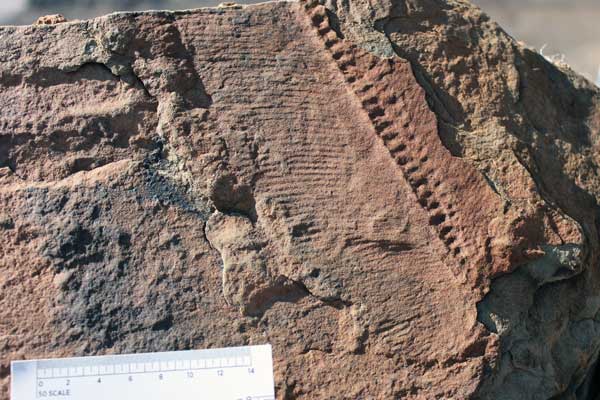
U of T prof unlocks mystery of an ancient mass extinction
Published: October 1, 2015
University of Toronto Mississauga paleontologist Marc Laflamme spends his summers exploring the rocky red canyons of Namibia, searching for the faint fossilized remains of a long-extinct and very unusual creature.
Neither animal nor vegetable, the biotas of the Ediacaran period were the earliest large, complex life forms on the planet, dominating salt oceans for nearly 40 million years. Very little is known about the soft-bodied creatures, except that they mysteriously disappeared about 500 million years ago, and have no living relatives today.
While the life of the creatures remains something of a mystery, Laflamme and his colleagues may have unlocked the secret of how and why the Ediacarans died out at the beginning of the Cambrian period. Ecosystem engineering by newly-evolving animals radically changed the Ediacaran environmen, causing the demise of the unusual organisms. The team’s research is published in the September edition of the Proceedings of the Royal Society B.
The researchers examined three theories about why the Ediacaran creatures disappeared.
“We theorized that the disappearance of Ediacarans could be due to a lack of (fossil) preservation, a catastrophic mass extinction due to climate change, or something else,” Laflamme says. The answer, to the team’s surprise, turned out to be the third option.
But before they could prove that theory, the team had to actually locate the fossils. The team looks for subtle tube-like impressions in the rocks by the soft-bodied organisms that lived on the floor of long-gone salt-water bodies.

“It’s a challenge to find fossilized records,” Laflamme says. There are about 50 sites around the world where Ediacaran fossils are found but, according to Laflamme, the Namibian site is a fossil bonanza.
“It marks the boundary of the Ediacaran world and the animal world, so we can study how ecosystems changed,” he says.
Geochemistry ruled out the catastrophic mass extinction theory. “Conducting tests on the chemical composition of the rocks tells us if we were dealing with environments that were oxygenated or undergoing a stressful change,” he says.
Positive results would have shown changes in ancient environments due to massive climate change, a volcanic activity or meteor impacts.
“We looked for evidence in the geochemistry, but our data didn’t show evidence of environmentally-driven extinction.”
But a different look at the fossil record revealed a surprising answer to their query, suggesting that “ecosystem engineering” caused the Ediacaran to disappear.
“Ecosystem engineers are organisms that significantly alter their environment,” Laflamme says. “Clams, for instance, can filter a lot of bacteria and nutrients out of the water, which causes problems for other creatures that need those resources.
“Something came in and shook up the Ediacaran system,” he adds. “We hypothesized that it had to do with the evolution of new life, and asked ourselves, ‘What happens when you introduce new biology to a system?’”
The researchers found fossil evidence of new animals – worms and worm-like animals – burrowing into sediment on the ocean floor.
“We can see trails all over the place, showing evidence of different behaviours like burrowing, feeding and den building,” Laflamme says. “We documented how new populations of Ediacaran biota responded to the presence of things that we knew, for sure, were animal fossils.”
“The new organisms would have disrupted the layer of bacteria along the sea floor that Ediacaran biota likely fed on,” Laflamme says. “It made it difficult for anything that didn’t move to survive.“
Delicate and sedentary, the Ediacarans couldn’t move or adapt, leaving them vulnerable to the effects of emerging new animals that disturbed the ocean environment. Unable to compete with the new animals for ecosystem space for nutrients, for space on the sea floor, and for food and oxygen, the biota were edged out by animals who were better adapted to use the available resources.
Laflamme’s research team included UTM graduate students Thomas Boag and Sara Mason. Funding was provided by Yale Peabody Museum of Natural History, NASA Astrobiology Institute, the Connaught Foundation, National Science and Engineering Research Council of Canada, National Science Foundation-Earth Sciences and the National Geographic Society.
Hear Marc Laflamme talk about his research on CBC Radio’s Quirks & Quarks program



